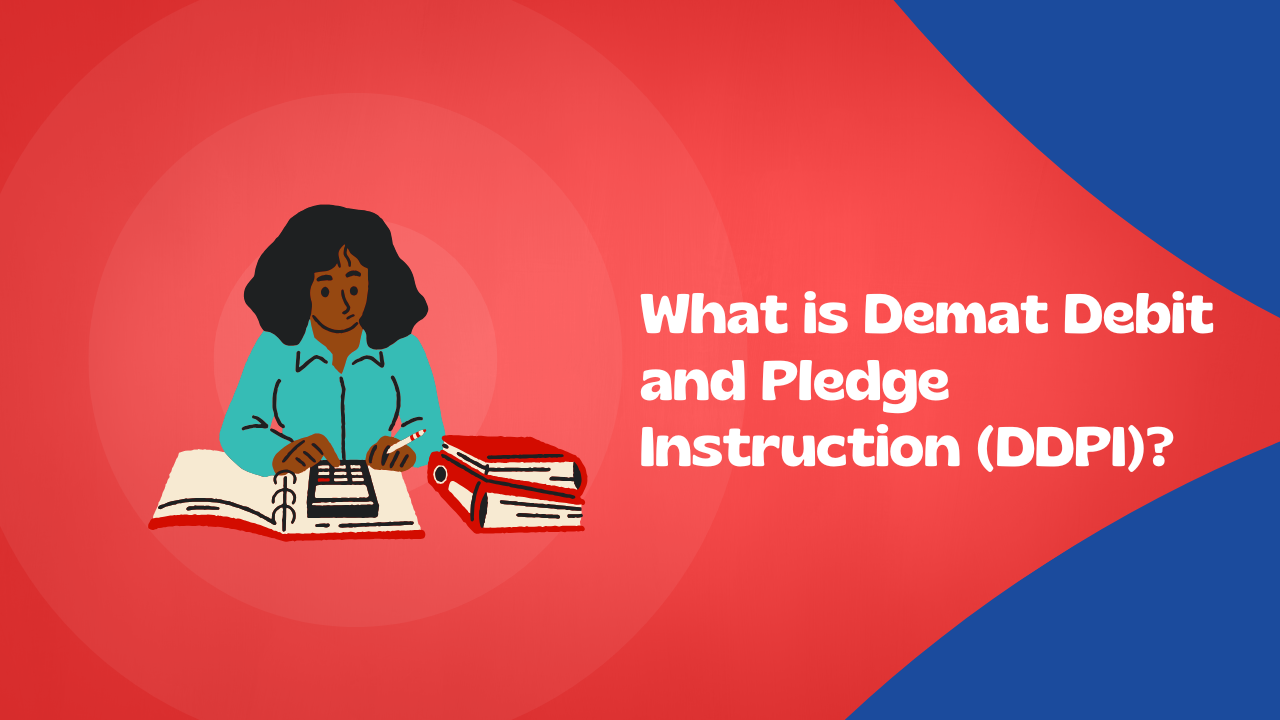What is Demat Debit and Pledge Instruction (DDPI)? Explained
In today’s digital era, investing in stocks, mutual funds, bonds, and other securities has become far more accessible than it used to be. With online trading platforms, investors can buy or sell securities with just a few clicks.
However, behind the scenes, every transaction involving shares and securities requires a certain degree of authorization and security to protect investors’ interests. This is where the Demat Debit and Pledge Instruction (DDPI) comes into play.
Many investors encounter the term DDPI when they open a Demat account or initiate a transaction, but may not fully understand what it is, why it was introduced, or how it benefits them.
In this article, we will break down the concept of DDPI in simple language, explain its significance, and help you understand why it matters for both beginners and seasoned investors.
Understanding the Basics: What is a Demat Account?
Before we dive into DDPI, let’s quickly recap what a Demat account is. A Demat (Dematerialized) account is an electronic account that holds your shares, mutual fund units, bonds, or other securities in digital form. Just like a savings account holds your money, a Demat account stores your investments securely.
Whenever you buy or sell shares, your Demat account is either credited or debited accordingly. Since the shares are in electronic form, the transfer process is quick and efficient; however, it also requires authorization to prevent unauthorized transactions.
What is Demat Debit and Pledge Instruction (DDPI)?
Demat Debit and Pledge Instruction (DDPI) is an authorization given by an investor to their stockbroker or depository participant (DP), allowing them to debit securities from the investor’s Demat account when shares are sold or pledged for margin or loans.
In simple terms, DDPI is like a “one-time permission slip” that lets your broker carry out transactions on your behalf in specific situations, without you having to sign a physical slip or give repetitive approvals every time you sell or pledge securities.
Earlier, investors had to provide a Power of Attorney (POA) to brokers to authorize such debits. However, POA often gave brokers sweeping powers, sometimes beyond what was necessary. To enhance security and transparency, market regulator SEBI introduced DDPI as a safer, limited, and investor-friendly alternative to POA.
Why was DDPI Introduced?
For many years, the Power of Attorney (POA) system was the standard practice. Under the POA, investors allowed brokers to debit securities from their Demat accounts, which made online trading seamless. However, POA had certain drawbacks:
- It gave brokers broad powers that could be misused.
- Some investors were uncomfortable signing the POA due to the legal implications.
- SEBI received complaints about unauthorized use of POA by a few brokers.
To address these concerns, SEBI introduced Demat Debit and Pledge Instruction (DDPI) in 2022. Unlike POA, DDPI is restricted to very specific purposes, such as:
- Debiting securities from your Demat account for settlement when you sell them.
- Pledging or re-pledging securities in case you are availing of margin funding or loan facilities.
This change brought in more safety, transparency, and trust for investors, while still keeping the trading process smooth.
Key Features of DDPI
Let’s understand the major features that make DDPI different and important:
- Limited Authorization – Unlike POA, which has wide-ranging powers, DDPI only authorizes debiting and pledging of securities. Your broker cannot misuse it for other purposes.
- Optional Facility – Signing a DDPI is not compulsory. Investors can still authorize transactions using physical slips (Delivery Instruction Slips or DIS) if they prefer. However, DDPI makes the process faster and more convenient.
- One-Time Signing – You don’t need to give approval every time you sell or pledge securities. Once you sign DDPI, it covers these specific actions for all future transactions.
- Regulator Backed – DDPI was introduced under the guidance of SEBI, making it a standardized and trusted process across brokers and depositories.
- Investor Protection – Since DDPI is limited in scope, it reduces risks of unauthorized activities, ensuring higher investor safety compared to POA.
How Does DDPI Work in Practice?
Here’s a step-by-step look at how DDPI functions when you trade:
- Opening a Demat Account – When you open a new Demat account, your broker may give you the option to sign a DDPI. If you already have a Demat account, you can submit DDPI separately later.
- Selling Securities – Suppose you sell 100 shares of a company. Your broker needs to debit those shares from your Demat account and deliver them to the exchange for settlement. With DDPI in place, your broker can do this automatically, without asking you for a Delivery Instruction Slip each time.
- Pledging Securities – If you take loan against shares (to trade with borrowed funds) or pledge shares to avail a loan, DDPI authorizes the broker to pledge/re-pledge your securities on your behalf.
- No Extra Powers – Your broker cannot misuse DDPI for other transactions like transferring shares to another account or withdrawing funds. It is strictly limited to settlement and pledging purposes.
DDPI vs. POA: What’s the Difference?
To better understand why DDPI is considered safer, let’s compare it with the old system of POA:
| Aspect | Power of Attorney (POA) | Demat Debit and Pledge Instruction (DDPI) |
| Scope | Broad powers given to broker | Limited to debit and pledge only |
| Investor Safety | Risk of misuse | Higher safety, reduced scope |
| Regulatory Approval | Initially industry-driven | SEBI-backed and standardized |
| Compulsory | Often mandatory earlier | Completely optional |
| Process | Allowed brokers to transfer securities even to their own accounts | Only for settlement and pledge activities |
This comparison shows why SEBI replaced POA with DDPI as a more investor-friendly system.
Benefits of DDPI for Investors
The introduction of DDPI has several advantages for investors:
- Convenience – No need to sign physical slips for every trade. Once authorized, trading becomes seamless.
- Security – DDPI restricts broker powers, reducing chances of misuse.
- Transparency – Investors know exactly what the authorization covers.
- Optional Choice – Those who don’t want DDPI can still use traditional methods.
- Faster Settlement – Since approvals are automated, trades get settled quickly.
Should You Opt for DDPI?
If you are an active trader or frequently pledge securities for margin or loans, signing a DDPI makes sense because it saves time and effort. It ensures the smooth execution of trades without compromising your safety.
On the other hand, if you trade occasionally and are cautious about giving any authorization, you can choose not to sign DDPI and continue with manual slips. However, this might slow down your transactions.
In most cases, investors find DDPI to be a safe and practical solution, especially since it is tightly regulated by SEBI.
Conclusion
The Demat Debit and Pledge Instruction (DDPI) is a thoughtful initiative by SEBI to make the Indian stock market ecosystem safer, more transparent, and investor-friendly. It bridges the gap between convenience and security, offering investors peace of mind while ensuring smooth transactions.
By limiting broker powers and giving investors more control, DDPI builds trust in the trading system. If you are someone who trades or pledges securities often, opting for DDPI can make your investment journey easier while keeping your assets secure.
As with any financial decision, take time to understand how it works, weigh the pros and cons, and then decide whether signing a DDPI suits your investment style. In the long run, DDPI is expected to become the standard practice, replacing the old POA system entirely, thereby empowering investors with both safety and efficiency.
Frequently Asked Questions (FAQs)
1. Is DDPI mandatory for all investors?
No, DDPI is completely optional. You can continue using Delivery Instruction Slips (DIS) if you prefer not to sign them.
2. What makes DDPI safer than POA?
DDPI gives brokers limited powers only to debit or pledge securities. Unlike POA, it cannot be misused for transferring securities to other accounts or withdrawing funds.
3. Can I revoke DDPI after signing it?
Yes, you can revoke DDPI anytime by submitting a written request to your broker or depository participant. After revocation, you’ll need to authorize each transaction manually.
4. Does DDPI allow fund transfers from my bank account?
No, DDPI does not authorize any bank-related transactions. It is strictly limited to securities debit and pledge.
5. What happens if I don’t sign the DDPI?
You can still trade, but you’ll need to fill in a DIS each time you sell or pledge securities. This may take more time compared to DDPI.
6. Is DDPI applicable across all my Demat accounts?
No, DDPI is account-specific. If you have multiple Demat accounts with different brokers, you must sign DDPI separately for each.
7. How do I sign a DDPI?
Most brokers provide DDPI forms at the time of account opening. Existing investors can sign it later, either physically or through an e-sign process (if available).

